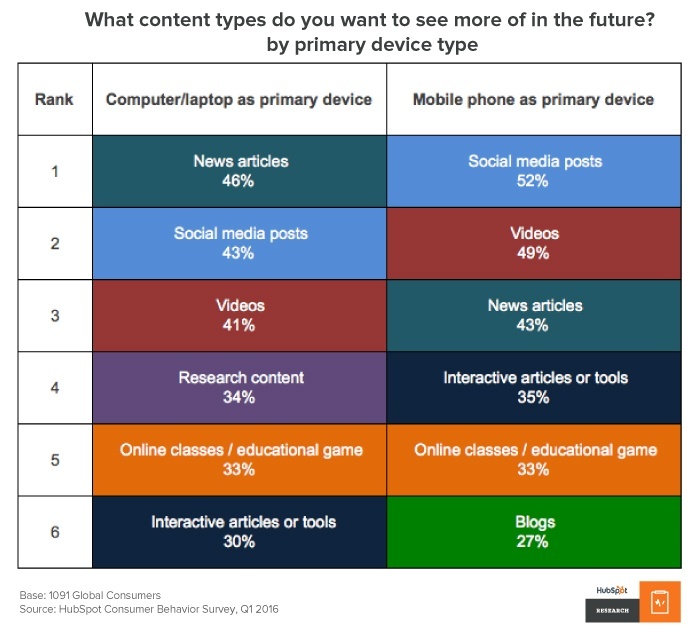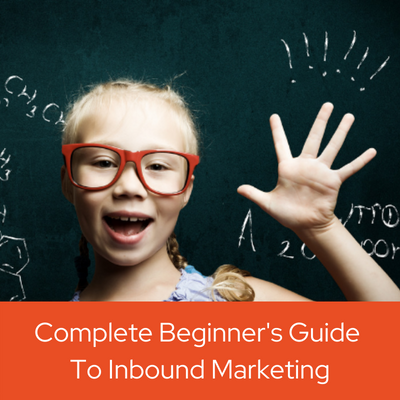How to Adjust Your Content Strategy to Fit Today's Mobile-First Consumer
Today, HubSpot published its "State of Inbound 2016" Report (you can download the full report at the end of this blog post), and we got to take a sneak peek! In previous years, this annual study has served to take the pulse of the current marketing and sales priorities all over the world by surveying thousands of marketers in various industries.
We took a closer look at the data and, over the next few days, we will share with you some incredible insight that we have gleaned. One of the biggest "Aha!" discoveries for us was in content marketing. The report confirmed observations we have made over the past 12 months: The way people CONSUME content changed in three very important ways that will have consequences affecting how we marketers approach and create content from now on.
Content Consumption Has Changed Significantly
Take a moment and think about how you consume most of your content. How do you access news or the latest business and lifestyle stories? If you are like most people, you access it that on your smartphone or mobile device and on social media.
Content Consumption Has Increased Through Social Media
HubSpot Research recently published supporting data that will provide more context: While 79% of people still search for content on search engines, 76% of respondents answered that they read through their Facebook feed and click on interesting articles or videos to discover new content. This means content consumption has increased on Facebook alone by 57% compared to last year — hands down the biggest change!
This massive tidal wave of change is supported by the jumps in popularity of mobile notifications as well as by the rise in discovering interesting articles when scrolling through their Twitter (41%) and LinkedIn (36%) feeds, which gained 25% and 21% compared to last year. Also worth mentioning here are Slack and Medium, which are sure to gain more momentum in the coming 12 months.

Consequently, most content discovery is trending towards almost passive discovery on social media. Or as the State of Inbound states:
"Consumers are increasingly turning to social media, messaging apps, and bots for content via their mobile. This means that content consumption is becoming decentralized across the web. Today, marketers’ content strategy should extend beyond their own blogs and website, and include publishing through external outlets. "
Content Is Primarily Consumed From A Mobile Device
Now that we know the channels your audience is using to consume content, let's have a look at the devices. According to the study, 56% of the respondents access the internet on a computer or laptop, while 33% use their smartphones and 11% their tablets. Consequently, 44% of all respondents use some mobile device to surf the internet.

While most respondents in the survey said they use non-mobile devices to access the internet, this does not reflect how much time they spent using the device. In fact, most smartphones and tablets make up 60% of digital media time spent according to a comScore study in 2014.
Mobile-First Users Consume Different Content
Which type of content they are consuming also greatly depends on which device they are using.
While people look primarily at news articles (46%), social media posts (43%), videos (41%), and research content (34%) if they are using their laptops or computers to access the internet, people who use their smartphones or tablets as their primary device to access the internet will read social media posts (52%), watch videos (49%), read news articles (43%) and consume interactive articles or tools (e.g., a quiz or a poll).

How To Serve Content That Is Optimized For Mobile First
There is a reason why the Huffington Post and BuzzFeed are so successful! I am not saying you should use click-bait headlines (you know, the "You won't believe what happened next" kind of stories), but they realized the potential of short content that can be quickly consumed and is highly shareable on social media. So, here are five tips to make sure you not only survive the switch to mobile-first, but come out on top:
Make Sure Your Website Is Mobile-Responsive & Optimized
I feel like this goes without saying, but since there are so many websites out there that are not mobile-responsive or mobile-optimized, I just want to stress the point again: If you have a poor mobile user experience, you will lose traffic to sites that have a better mobile experience. To test if your website is good to go, please use the Google Test, but also try it out yourself!
Give Your Visitors The Type Of Content They Want
As content decentralizes (away from our websites and moving more into satellites like social media), you have to find a mix of snackable and easy-to-share social media posts and content that keeps people coming back to your website. Also, make more short videos, create interactive quizzes and educational or fun polls, and educational games or classes in addition to the news and blog articles.
Make Your Headline Count
While click-bait is not the way to go, there is a lesson to be learned from it. 80% of people will read the headline if they see your post, but only 20% will click through to scan it. So make sure you spend enough time carefully crafting your headline! Keep it short, but enticing.
Keep Your Content Short & Sweet
If you find that your audience likes to scroll through their Twitter feed while waiting, quickly scan LinkedIn updates during their commute, or scroll through their Facebook feed at night in front of the TV, rather than read research-based long-form articles (more than 1,500 words), make sure to keep your articles short and sweet.
Optimize Your Content For Voice Search
According to The State of Inbound study, "people are turning toward voice technologies and conversational UIs to search for content on demand. These trends aren’t a faddish blip. Traditional search engine providers have taken notice and are building conversational search into their own product plans."
- Be local optimized, as voice search is used more for local searching, i.e. "Find me a restaurant near me" or "Find a restaurant in New Brunswick."
- Focus on long tail keywords and sentences; searches are not saying "Restaurant New Brunswick" with voice search.
- Focus on answering and asking questions that would be asked in voice, with blog posts on specific topics and an FAQ.
- Have a mobile friendly/responsive site as most mobile searches are done using mobile!
Download The State of Inbound 2016 Report
This is just one lesson learned from this year's State of Inbound report. You can download the entire report here:
Share this
You May Also Like
These Related Stories

Be Awesome Or Stop Writing: Surviving The Inevitable Content Apocalypse

The Future of Content Management: Navigating Generative AI's Impact on Blogging

.png?width=250&height=125&name=TrustBuilderLogoWhiteTranspBackgr(250x125%20px).png)



No Comments Yet
Let us know what you think